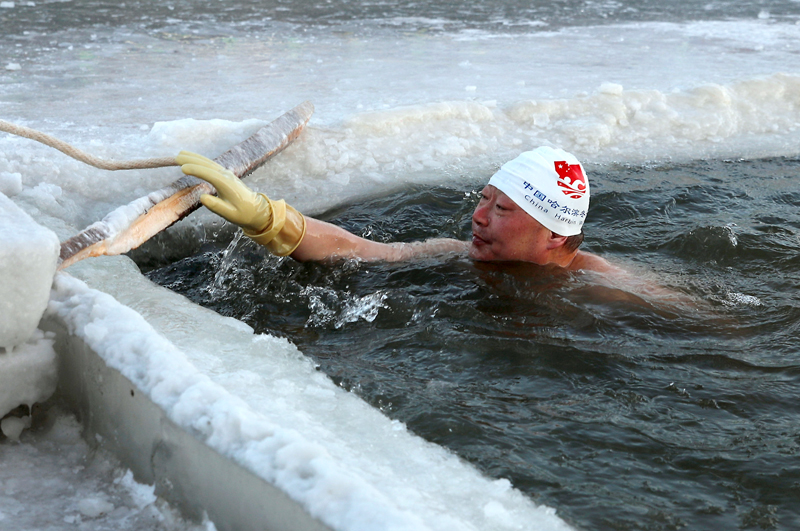Cool it: beat the heat with ice

At the time of writing, the official start of summer in the northern hemisphere is just two days away. Of course, summer is always the warmest time of year, but long range forecasts suggest that in Europe and the US this summer, warmer than average weather may predominate thanks to the transition in the Pacific ocean from ‘La Nina’ to ‘El Nino’. However, while warm summer weather is definitely enjoyable, it can present real challenges to endurance athletes who have to train or compete in the heat.
The need for cool
When conditions turn hot, particularly when humidity is high, it’s not just the risk of dehydration from sweating that can severely hamper endurance performance. Staying cool is crucially important too because even a small rise in your body’s core temperature can adversely impact how long and how hard you can sustain vigorous exercise(1). The use of appropriate cycling garments and taking plenty of drinks can help of course, but once the mercury climbs, it’s difficult to avoid at least some degree of heat buildup.
To try and combat heat build-up during exercise, a number of cooling strategies have been developed over the years, all with the goal of reducing or keeping core temperatures from rising too much, and to make athletes feel more comfortable (ie reduce thermal distress). These cooling strategies can be classified into external (eg cold-water immersion, ice packs, ice vests, cold-water sprays etc) and internal (ingestion of ice, cold-water, and menthol) applications. A number of review studies have found that all of these methods can help athletes keep cool or reduce core temperatures, with external cooling applications such as cold water immersion and ice vests being particularly effective(2-5).
The problem is that not every cooling method that produces performance benefits in the lab setting is feasible for real-life competition (particularly external methods), where practical considerations and sport-specific regulations would rule it out – for example, trying to jump in a cold water immersion tank halfway through a marathon! In contrast, internal cooling via the use of cold water, ice and menthol drinks are much more practical in a field-based setting, and are usually well-tolerated and cheap(6).
Ice, ice baby
Of these internal cooling strategies, consuming ice drinks in the form of a slurry offers particular advantages for heat removal. If you’re of a certain vintage, you’ll probably remember the ‘Slush Puppy’ ice slurry drinks, and if you have kids, you’ll probably be aware the ice slurry drinks have made something of a comeback in recent years! But what is it about these ice slurry drinks that make them of special interest to athletes performing in the heat?
Any very cold drink can help reduce the body’s core temperature by absorbing excess heat. However, consuming ice slurry at 0oC is far more effective at cooling the body than consuming water at 0oC because it takes large amounts of heat energy (absorbed from the body) to turn ice at 0oC to water at 0oC. This heat energy to turn solid ice at 0oC to water at 0oC is more technically known as the ‘latent heat of fusion of water’.
Compared to other solid-to-liquid phase transitions, the latent heat of fusion for water at 0°C is high - approximately 334 joules (79.7 calories) per gram of ice that turns to water. Consume a drink containing 200 grams of ice therefore, and it’ll take nearly 16,000 calories (16Kcals) of heat energy just to turn that ice to water at 0°C = heat that is removed from the surrounding body tissues, thus exerting a strong internal cooling effect.
Of course, the 200 grams of water at 0°C continues to absorb heat until it reaches the same temperature as the surrounding tissues – around 37°C. Using the specific heat of water (4.184 joules per gram per degree Celsius), we can further calculate that this process will require 200 x 37 x 4.184 joules of energy = 30,961 joules, which is equivalent to 7,370 calories – ie 7.37Kcals. The total energy removed from the body when consuming 200 grams of ice slurry then is around 16Kcals + 7.37Kcals = 23.37Kcals – but notice that more than twice as much heat is absorbed in the ice-to-water process than heating up that water to body temperature. Now you know why ice is king for cooling!
Research on ice drinks
The use of ice slurry drinks for cooling athletes in hot weather and thus boosting endurance performance is a relatively recent practice but by no means brand new. In fact, the earliest report study on ice slurry ingestion during exercise to enhance performance was by a team of Singapore researchers back in 2012(7). They found that ingesting ingested 8 grams of ice slurry per kilo of body weight prior to a 10km time trial run led to faster running times than no slurry ingestion.
However, the first reported use of ice slurry ingestion during a demanding event in hot conditions came the following year in a study on triathletes(8). In this study, nine well-trained male triathletes performed two randomized trials of a simulated Olympic distance triathlon in temperatures of 32-34°C. Exercise intensity during the swim (1500m) and cycle (1-hour) legs was standardized, but the 10km run leg that followed was a self-paced time trial during which the subjects ran the distance as fast as they could. During the cycle leg of each trial, the subjects drank either 10g per kilo of bodyweight of ice slurry or the same amount of the same type of fluid at room temperature (32-34°C).
The results were pretty convincing. When the triathletes drank the ice slurry, their subsequent performance in the run leg was significantly faster – an average time of 43.4 minutes when ice slurry was consumed vs. 44.6 minutes when room temperature drinks were taken (see figure 1). This effect was very noticeable during the last 0.5km of the run when the subjects’ oxygen consumption levels (and therefore power outputs) were nearly 10% higher when ice slurry was consumed. The researchers concluded that the consumption of ice slurry resulted in a less steep rise in stomach (and therefore core) temperatures, which had reduced the perceived heat stress and allowed the triathletes to work harder during the running leg.
Figure 1: 10km run times – ice slurry vs. water
You need to be logged in to continue reading.
Please register for limited access or take a 30-day risk-free trial of Sports Performance Bulletin to experience the full benefits of a subscription. TAKE A RISK-FREE TRIAL
TAKE A RISK-FREE TRIAL
Newsletter Sign Up
Testimonials
Dr. Alexandra Fandetti-Robin, Back & Body Chiropractic
Elspeth Cowell MSCh DpodM SRCh HCPC reg
William Hunter, Nuffield Health
Newsletter Sign Up
Coaches Testimonials
Dr. Alexandra Fandetti-Robin, Back & Body Chiropractic
Elspeth Cowell MSCh DpodM SRCh HCPC reg
William Hunter, Nuffield Health
Keep up with latest sports science research and apply it to maximize performance
Today you have the chance to join a group of athletes, and sports coaches/trainers who all have something special in common...
They use the latest research to improve performance for themselves and their clients - both athletes and sports teams - with help from global specialists in the fields of sports science, sports medicine and sports psychology.
They do this by reading Sports Performance Bulletin, an easy-to-digest but serious-minded journal dedicated to high performance sports. SPB offers a wealth of information and insight into the latest research, in an easily-accessible and understood format, along with a wealth of practical recommendations.
*includes 3 coaching manuals
Get Inspired
All the latest techniques and approaches
Sports Performance Bulletin helps dedicated endurance athletes improve their performance. Sense-checking the latest sports science research, and sourcing evidence and case studies to support findings, Sports Performance Bulletin turns proven insights into easily digestible practical advice. Supporting athletes, coaches and professionals who wish to ensure their guidance and programmes are kept right up to date and based on credible science.









